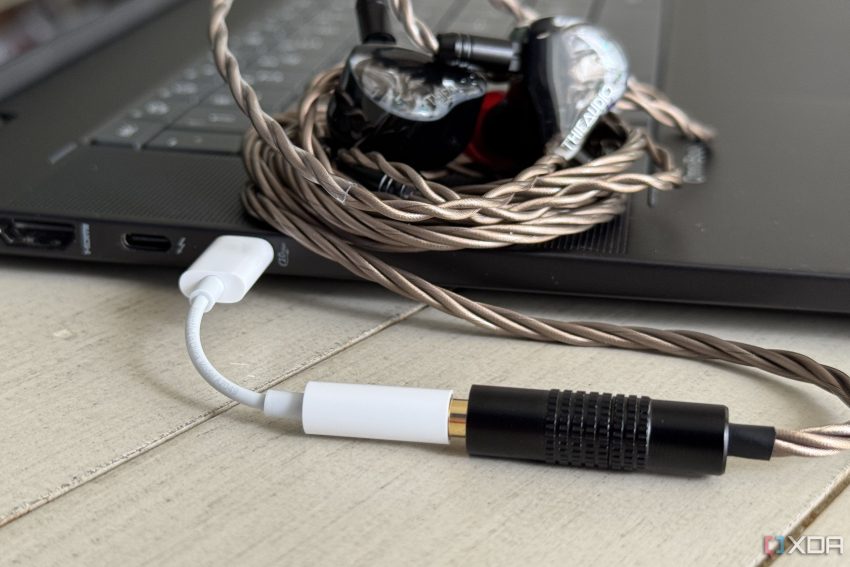The Hidden Gem of Affordable Audio Solutions
If you’re serious about the audio quality from your computer, you know that the onboard sound chip often leaves something (or lots of somethings!) to be desired. Whether you’ve decided on a great pair of over-ear headphones or IEMs for your gaming needs, to get the best out of them, adding a capable audio interface or DAC/Amp stack is next on your shopping list.
Asking around for suggestions will make you dizzy. The range of options and price tiers makes putting together a shortlist a daunting task, and that’s before you start looking at reviews, specifications, and measurements. I’m not going to say you shouldn’t do that, because you totally should, but while you go through the arduous process, you deserve to have better audio coming from your PC, and just $9 will do that. I’m talking about the humble Apple USB-C to Headphone Jack adapter, which isn’t only the most affordable thing Apple sells, but it’s also one of the company’s hidden gems.
A Marvel of Miniaturization
The Apple USB-C to Headphone Jack adapter is something special. It’s tiny. Inside is a stereo-to-analog converter (DAC), stereo headphone amp, microphone preamp, monophonic analog-to-digital converter (ADC), and power circuitry to run everything. It’s a marvel of miniaturization and is as powerful (if not slightly more) than the 3.5mm circuitry in the iPhone 5S before Apple removed it entirely in the next generation.
That also means this dongle works with 4-pole headsets with microphones, so it’s a complete audio solution for your computer (or anything else with a USB-C output, although some users say it’s quiet on Android devices). But it also supports in-line controls, so if you’ve got play/pause and skip controls on your headphones, it’ll pass the control signal down to your computer, which is fantastic and something most USB DACs won’t do.
Performance That Surpasses Expectations
I’ve used more stacks than I can count, and the Apple USB-C audio adapter genuinely surprised me. It’s powerful enough for all but the hardest-to-drive headphones, has a clean, low-noise floor for sensitive IEM use, and, more importantly, costs less than $10.
It’s not often you find an inexpensive audio product that performs similarly to devices many times its cost, but the Apple audio dongle is one such unicorn. Its output impedance is less than one ohm, which makes it easy to pair with headphones or IEMs, and is nearly at ideal levels. You’d have to spend substantially more to get this performance.
A Versatile and Practical Choice
When plugged into a computer, this adapter provides up to 24-bit 48kHz stereo sound, which is plenty for gaming, watching movies, and most audio sources. It doesn’t mean you don’t get high-res output for use with Apple Music, Tidal, Qobuz, etc., but it’s still decent quality for the price. Plus, you get microphone input and in-line controls, if your headphones support them, headphone sensing so it turns off when no headphones are plugged in, and has a short cable so you’re not swimming in extra.
I’ve used mine with $20 IEMs, $1,000 IEMs, and almost every headphone I own, and I still can’t quite get over how good this little dongle is. Unlike many other audio sources, it does an excellent job of staying neutral, so the inner audiophile will not be lacking dynamics, imaging, or clarity.
A Must-Have for Every Device
Something inexpensive rarely outperforms its more premium counterparts, and it’s absolutely unheard of with Apple devices. The Apple audio dongle (or more correctly, the USB-C to Headphone Jack Adapter) is a diamond in the rough, a unicorn product that came from Apple’s desire to remove the 3.5mm jack from the iPhone, while knowing that not offering an inexpensive alternative would harm retention rates.
It’s one of the best DACs you can buy for under $200, never mind under $10, and it has made a difference in audio quality on every device I’ve used. At $9, get a spare (after all, it’s tiny and I’ve lost several already). This little adapter proves that sometimes the simplest solutions offer the most significant improvements.
